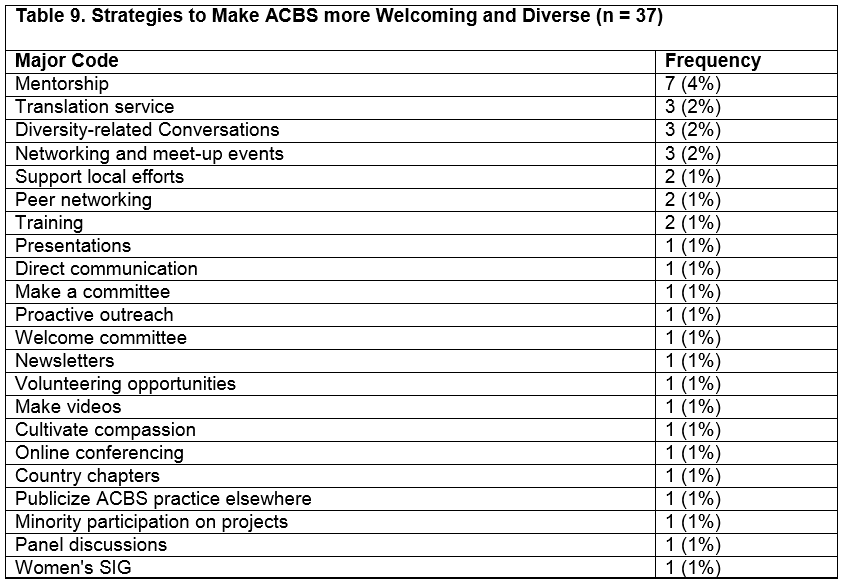Diversity Report
Diversity ReportACBS Diversity Survey Report - December 28, 2015
For: The ACBS Diversity Committee ... Niloo Afari, Dave Kovaka, Andrew Sherrill, Karen Regan, Gwyneth Williams, Ann Eberhardt
ACBS Diversity Committee Mission Statement:
The ACBS Diversity Committee is dedicated to creating a more inclusive ACBS community in all realms of the organization in respect and appreciation for diverse personal and professional backgrounds with different perspectives, experiences, and insights. The Committee endorses a broad definition of diversity that includes but is not limited to professional discipline and setting, communities of color, minority status, cultural and language perspectives, religious and spiritual beliefs, socioeconomic status, as well as sex, age, race, ethnicity, nationality, sexual orientation, gender identity, and disability. We seek to provide programs and resources that enhance inclusion, build and support relationships with other ACBS committees, and encourage greater diversity within the membership and leadership of ACBS.
Diversity Survey Summary of Findings
A. Introduction
The ACBS Diversity Committee conducted a membership-wide survey in 2014 in order to: a) better understand the needs of the growing ACBS membership; b) understand some of the barriers and facilitators to active participation within ACBS; and c) get input on directions to enhance inclusion and encourage greater diversity. A 27-item survey was therefore developed, which included a combination of multiple response and open-ended questions. A link to the web-based survey was sent to the entire ACBS membership (N ~ 7,200) as well as the ACT (n ~ 1,700) and RFT (n ~ 680) listservs. Members were encouraged to respond to this anonymous survey.
In collating the results, responses to the multiple choice questions were summarized and responses to the open-ended questions were reviewed by a team of coders. Each open ended question was coded by a single coder. Coders reviewed nearly 200 pages of write-in responses in order to identify themes falling into 3 categories: supportive experiences (what is working), unsupportive experience or barriers (what is not working), and strategies to improve support (suggestions).
B. Respondent Sociodemographic Characteristics
A total of 709 members (about 10% of the entire membership) responded to the survey and of those 541 had complete responses to every question. Nearly 60% of the respondents were female; 51% were in the 25-44 years age group, 22% in the 45-54 years, and 23% in the 55 years and older age groups. Of the 537 respondents who wrote in a response with regards to race/ethnicity, 428 (79.7%) indicated White or Caucasian. Nearly 85% identified as heterosexual. One half (50.5%) of respondents were from the United States, 11% from Australia, 7.05% from United Kingdom, 5.4% from Canada, 14.5% from a European country, and 1.8% from Central or South America. Thus, a total of 74% reported being from a Country in which English is the primary language (Figure 1). 73% of respondents reported having a professional membership and 20% reported a student membership. 34.5% identified their current profession as clinical psychologist, 6% as counseling psychologist, and 7.4% as another type of psychologist, indicating that nearly one half (47.9%) were psychologists. Another 9% identified their current profession as counselor, 8.32% as social worker, and 3.61% as physician/psychiatrist. Five individuals wrote in that they were in the nursing profession (RN, Clinical Nurse Specialist, or Nurse Practitioner). Correspondingly, 36% reported PhD level training, 38.34% reported Masters level training and 4% indicated having received training as an MD. 27.3% of respondents reported working in a private practice setting, 26% were working in a hospital or other clinical setting, and 19.5% were working in an educational or research setting.
C. Thoughts on Supportive Environment and Diversity
In response to the question “Does the ACBS community provide a supportive environment for the following members”, more than 70% of respondents agreed or somewhat agreed that the community was supportive of them personally but less than 40% agreed or somewhat agreed that the community was supportive of non-English speakers, members with disabilities, nurses, physicians, those working in non-MH settings, and ethnic and racial minorities (Figure 2). 36% of respondents agreed that they have some or a great deal to contribute to the community. Additionally, 60% of respondents agreed or somewhat agreed that one of the ACBS goals for increasing diversity should include mentoring. Other goals with high rates of agreement included: cultural competence (in use of ACT in practice), providing scholarship and funding, increasing diversity-related research, and outreach to students and trainees (Figure 3). When asked specifically about diversity goals (Figure 4), the 3 categories with the highest endorsement were cultural diversity (43.6%), professional diversity (35.4%), and socioeconomic diversity (31.2%). An additional 44 responses were written in, most of which were consistent with the pre-existing categories; disability (5) and religious affiliation (5) were identified as additional diversity dimensions that would be useful to attend to.
D. Goals in Joining ACBS
A set of survey questions focused on understanding the membership’s needs and interests within the organization, by asking about goals in joining ACBS (Table 1), and facilitators and barriers to those goals. When asked about their goals in joining ACBS, the majority (69%) indicated that they joined to learn about the latest developments in ACT and RFT, have access to clinical materials and expertise (67%), and have access to research materials and expertise (57%); the endorsement of these goals is consistent with a focus on gaining information and education. One third to one half of respondents endorsed goals that were consistent with networking, collaboration, and enhancing a sense of belonging. The goals of contributing to the latest developments in ACT and RFT (25%) and being able to add content like publications and training opportunities to the website (14%) were the least endorsed goals.
We also asked if respondents had found people within the community to help them achieve these goals. Only 43% said they had found help and 94% of these respondents (218 individuals; 31% of the total N) provided information on their strategies and types of help they had sought. The primary strategies (Table 2) for the type of help received revolved around various forms of clinical support through information (38%), training opportunities (26%), consultation (22%), supervision (18%), and emotional support (17%). The primary methods of connecting with help (Table 3) included attending trainings (39%), online forums (38%), and in person (28%).
Only 103 individuals (14.5% of the total N) responded to the question, “what do you think prevents you from finding people to support you” (Table 4). These respondents indicated that the biggest barriers to getting help were lack of time (29%), lack of need (12.6%), having joined just recently (10.7%), not sure how to connect or ask for help (8.7%), distance (8.7%), and not making the effort to find support (7.8%).
Only 152 responses were provided to the query for suggestions on ways to enhance the process for ACBS members to receive more support (Table 5). Of these, 27% suggested maintaining the status quo, and 15% were unsure. Specific suggestions to enhance a supportive environment included:
1. Providing training opportunities,
2. Improving the use of the website,
3. Providing financial assistance,
4. Increasing and improving chapter and sig activities,
5. Increasing conversation about diversity,
6. Establishing a mentorship program,
7. Improving forums for communication,
8. Increasing/improving newsletters.
E. Use of ACT and RFT Listservs
We also wanted to get some information about the mode and style of communication that would be conducive to greater participation. Although a minority of the ACBS membership is on the ACT and RFT listservs, these are our most prominent avenues to communication. Thus, several questions asked about the ACT and RFT listservs in order to examine barriers to the use of the listserv and suggestions to improve diversity and openness of the listservs.
Not all individuals who responded to the survey answered the questions about the listservs. Therefore, the sample size for questions 21-25 ranges from 457-501 individuals. 64% of respondents indicated that they read the ACT listserv often or occasionally, primarily because they find it useful to their understanding of ACT and RFT (33.7%), clinical work (32.7%), learning about the latest developments in ACT and RFT (30%), and research (12.1%). Another 25 write-in responses suggested that individuals read the ACT listserv for personal growth, to share resources and activities, networking, feeling connected, and modeling professional behavior. Alternately, 36% of respondents indicated that they read the ACT listserv infrequently or not at all, primarily because of not being a member of the listserv (10.6%), being too busy (12.3%), and not having anything to contribute (3.4%). There were 30 write-in responses that also indicated lack knowledge about the listserv, having just joined, and not knowing how to use the listserv as barriers.
Similarly, 29% of the respondents indicated that they read the RFT listserv often or occasionally because they find it useful to their understanding of ACT and RFT (14.1%), the latest developments in ACT and RFT (11.7%), clinical work (9.9%), and research (7.9%). Alternately, 71% of the respondents indicated that they read the RFT listserv infrequently or not at all, primarily because they were not a member of the RFT listserv (31.6%), were too busy (12%), and didn’t have anything to contribute (4%).
While 29-64% of respondents indicated that they read the ACT or RFT listservs, only 8% and
2.8% said they posted often or frequently to the ACT and RFT listservs, respectively. Primary reasons for not posting to either of the listservs were not being a member of the listservs, being too busy, and not having anything to contribute. For the ACT listserv, 6-11% of the responses expressed worries about how their responses would be perceived or that they might be wrong, or felt intimidated.
Question 25 asked, “In what ways do you find the ACT and/or RFT listservs useful” (Figure 5). The areas with greatest endorsement included: having access to clinical materials and expertise (47.8%), learning the latest developments in ACT and RFT (46.4%), having access to research materials and expertise (36.5%), and belonging to a group with shared values (35.3%).
F. Suggestions to Improve Listserv Use
Question 26 asked, “What suggestions do you have that might make posting on the listservs more welcoming to people who share your concerns?” There were 196 write-in responses to this question (Table 6); with 50% of the responses either indicating that the listservs were already welcoming or did not make any suggestions for improvement.
Respondents made several logistical recommendations to improve access and use of the listservs. The majority of these recommendations centered on making the listservs “easier to join” by:
1. Sending out emails to remind people to sign up for the listservs,
2. Sending welcoming email explaining the listserv process,
3. Providing regular information regarding the listservs,
4. Giving explicit instructions on how to join and how to access listservs.
Other recommendations included improving the organization of listservs so they are “easier to follow”, for example:
1. Allowing “keyword searches” to make it easier to find topics of interest,
2. “Trending post updates”,
3. “Improving thread organization” so it’s easier to find topics of interest,
4. Setting up a system by which individuals can choose to be alerted to topics of interest.
Other suggestions included alternate ways to access the listserv postings such as:
1. “Through the website”,
2. An “online URL/forum to read/post for those without regular access to email”.
Of note, several of the strategies described above are already in place. For example, new members do receive information on how to join the listservs and the listserv posts are on the website and therefore searchable for members who do not have regular access to email.
The majority of recommendations to encourage postings focused on:
1. Directly soliciting postings from infrequent posters, non-mental health professionals, and more female posters,
2. Posting discussion questions,
3. General encouragement by “big names”.
A subset of comments focused specifically on encouraging new members (newbies) by:
1. Establishing a forum with a moderator for newbies,
2. Providing mentorship to newbies,
3. Establishing a committee to respond to newbie and basic posts,
4. Hosting an intro session/webinar,
5. Providing general encouragement to newbies, students and beginner questions.
Comments regarding language and content included:
1. Posting in different languages or providing translation for the listservs,
2. Reducing the use of jargon and academic language,
3. Reducing activity on the main listservs by creating other listservs, for example, for referrals, employment opportunities, etc.,
4. Expanding the scope of the main listservs by discussing broader topics, for example, practice issues, more personal topics, and practical how-to guides.
5. Ask high volume posters to self-edit (e.g., suggest limit of one post a day)
G. What ACBS Does Right
Two questions obtained information on: a) what characteristics of the organization have been supportive of members (Question 17); and b) what ACBS does right about diversity (Question 27). Across these 2 questions, 178 comments addressed these topics.
Prominent supportive experiences included:
1. Welcoming environment,
2. Useful website materials,
3. Members responsive to each other’s requests,
4. Organization responsive to membership needs,
5. Affordable involvement.
73 comments focused on organization characteristics that are not supportive of the membership (Table 7). Prominent unsupportive experiences included predominating male gender, non- transparent organization, lack of cultural/developmental adaptation, predominance of English, inaccessible events, and perceived “micro-aggression”.
H. Suggestions and Strategies to Improve ACBS and Diversity
81 comments to Question 17 made suggestions about improving support for diversity (Table 8). These suggestions included:
1. Encouraging more participation for new and diverse members,
2. Promoting more supervision, mentorship, and consultation,
3. Promoting local events,
4. Improving affordability,
5. Promoting professional diversity.
Question 27 was the question that most directly asked for suggestions on how to make ACBS more welcoming or more useful to a diverse community. Despite the directive nature of the question, 42% of the 185 comments stated that they had no suggestions or ACBS was doing a good job or specified what ACBS does right. 37 comments made suggestions for improvement including (Table 9):
1. Increasing mentorship,
2. Providing translation service,
3. Increasing diversity-related conversations,
4. Networking and meet-up events,
5. Supporting local efforts.
I. Summary
Approximately 10% of the general ACBS membership responded to the survey, thus the findings may not be generalizable to the entire membership and should be interpreted with caution. Nonetheless, the demographics of the respondents were surprisingly similar to what we know of the ACBS membership in general: greater female to male ratio, primarily white, English- speaking, from the Unites States, and psychologist. We also found that more than ½ of respondents work in clinical settings. Given the demographic characteristics of the respondents, the results may not be applicable to members of minority groups. In other words, the majority of the respondents who gave us input about inclusivity are not necessarily diverse.
The primary goal when joining ACBS appeared to be gaining access to materials and expertise, which was typically received through clinical support, information, training opportunities, and consultation/supervision. Information collected about the use of the 2 main listservs (ACT and RFT) suggested that only a minority of the ACBS membership use the listservs, and those who do typically find it useful for accessing information, as opposed to making a contribution to the listservs. The apparent primary barriers to using and actively participating in the listservs are not being a member of the listserv, and a lack of time. Additionally, many of the suggestions to improve listserv use may already have been implemented.
Altogether, these results suggest that the ACBS membership may be highly clinically oriented and interested in using and applying information in their practice, and has been relatively less active in contributing to threads on the listservs. Therefore, the organization may want to explore other ways of engaging clinicians in dialogue.
Several questions obtained information about what groups were perceived to be poorly supported and what domains of diversity needed more work. Areas of diversity to increase that were suggested by respondents include:
1. Cultural diversity
2. Professional diversity
3. Socioeconomic diversity
Survey results suggested that Specific members that would benefit from greater support and engagement include:
1. Non-English speaking individuals
2. Persons with disabilities
3. Nurses
4. Physicians
5. Those working in non-mental health settings
6. Ethnic and racial minorities
The category of diversity that most participants endorsed as an area to increase was cultural diversity. In addition, many participants endorsed related sub-categories, such as language, nationality, race/ethnicity, etc. Collectively, this is indicative of the importance and salience of the topic of cultural diversity. It also suggests that the membership may have slightly different ways of framing the issue of cultural diversity pertinent to each person’s own experience.
The figures below detail in graphical format the statistics described in this report.
Figure 1. Respondents' Country of Residence
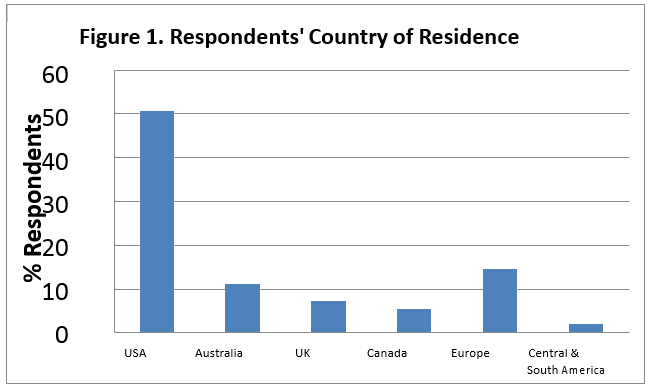
Figure 2. Does the ACBS community provide a supportive environment for the following members?
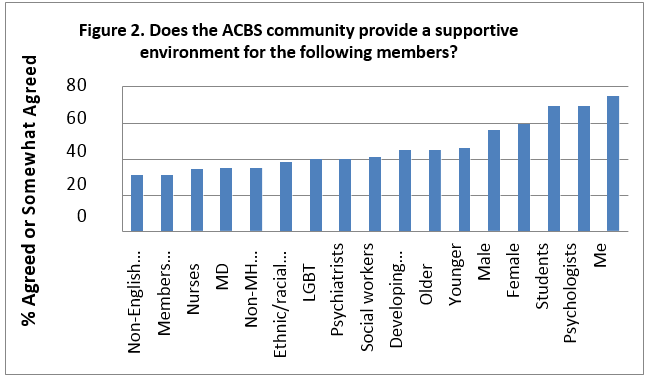
Figure 3. Should the ACBS goals for increasing diversity include…
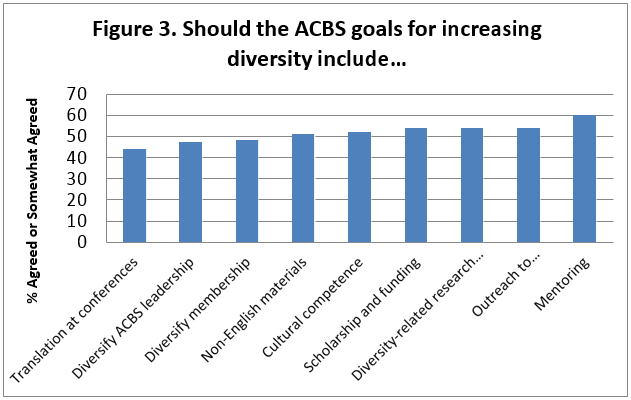
Figure 4. What Factors of Diversity should ACBS Focus on?
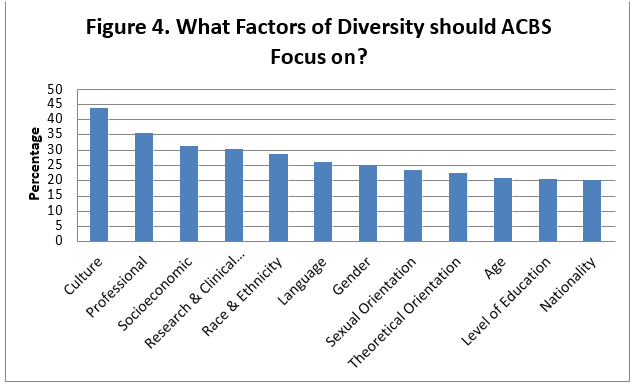
Figure 5. In What Ways Are Listservs Useful?
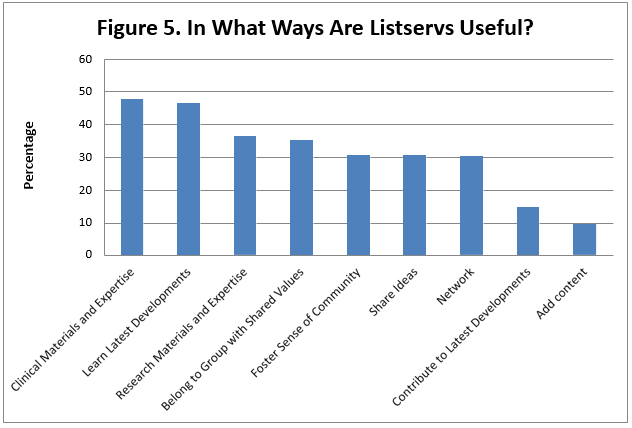
Table 1.
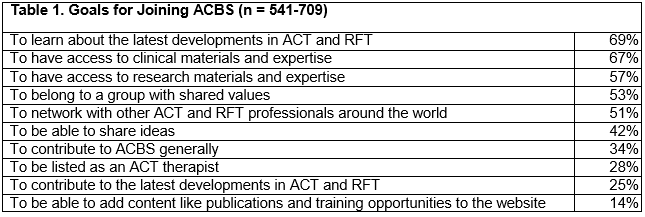
Table 2.

Table 3.
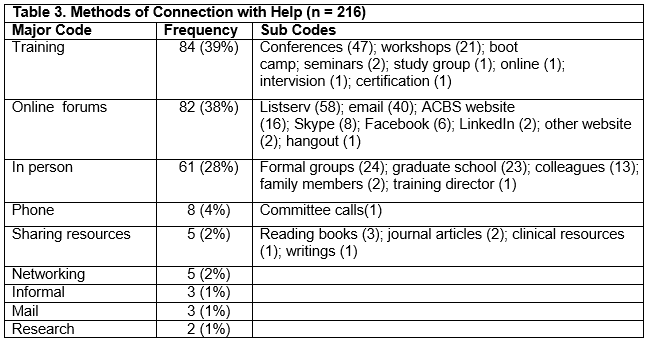
Table 4.
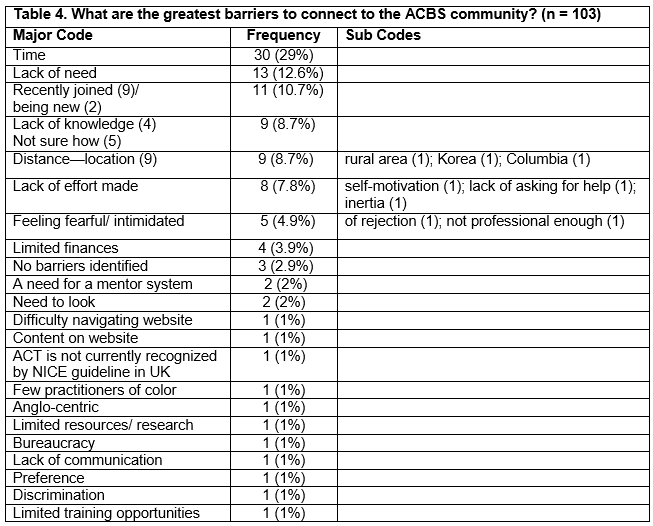
Table 5.
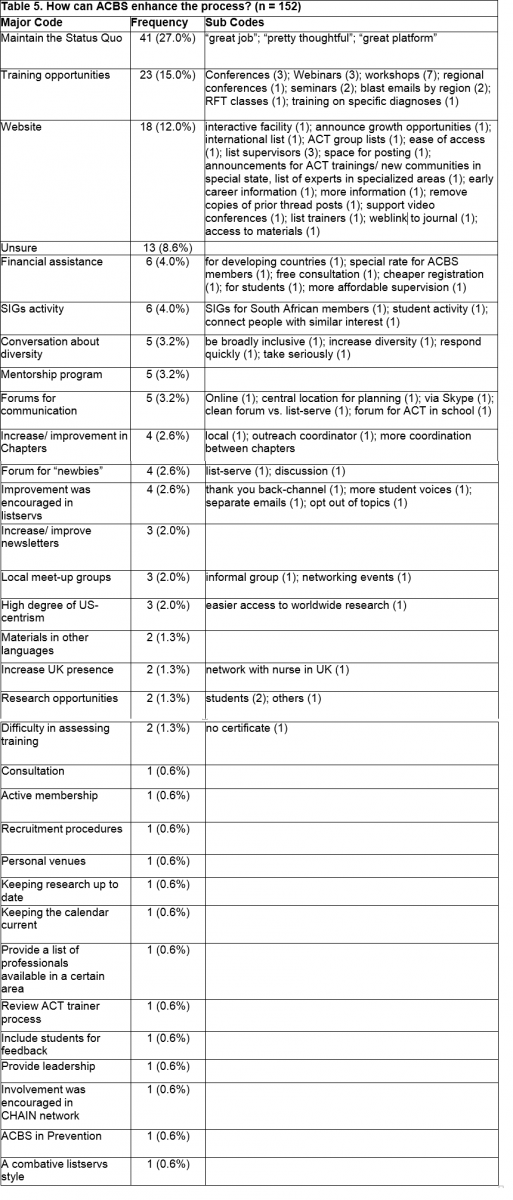
Table 6.
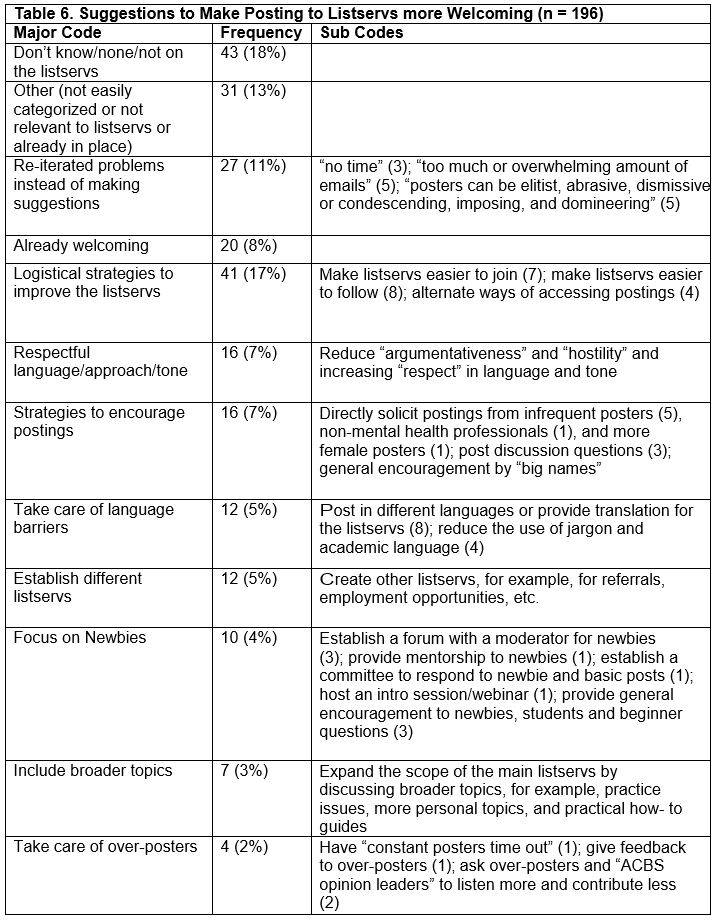
Table 7.
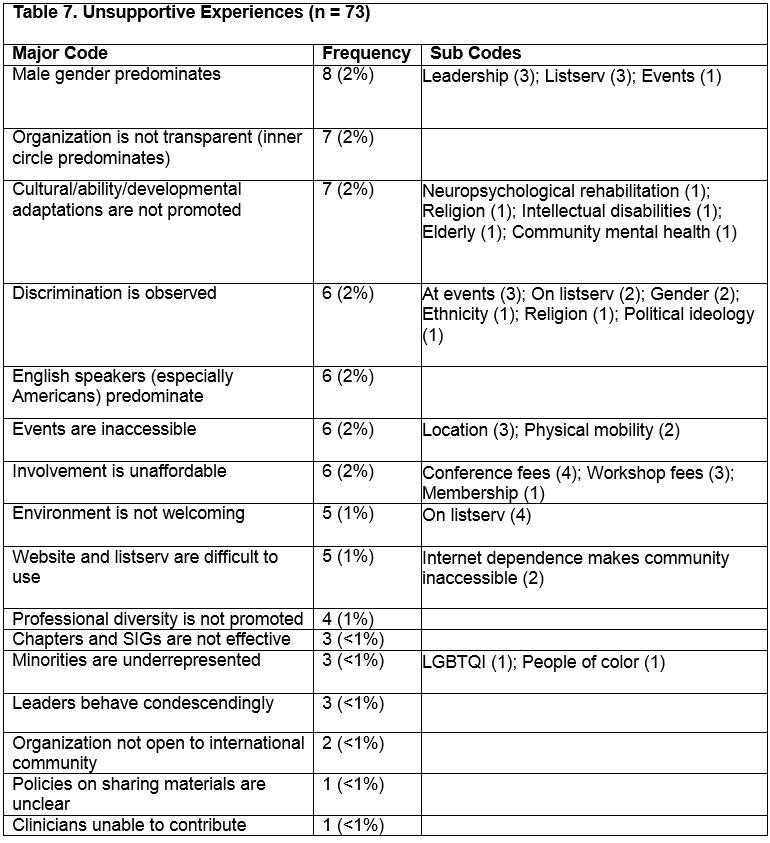
Table 8.
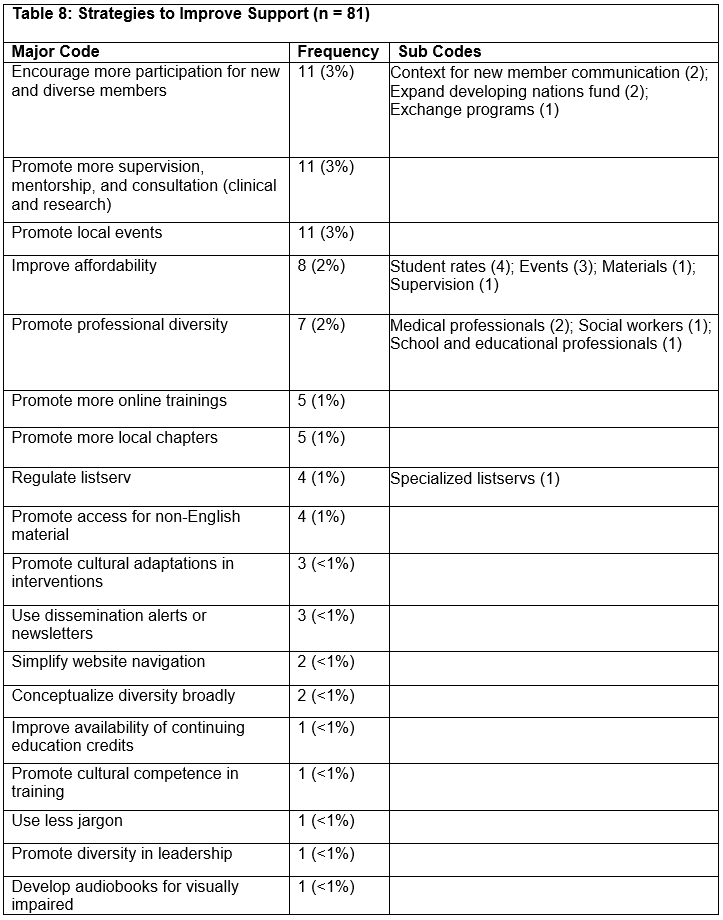
Table 9.
